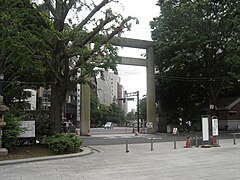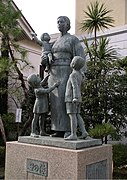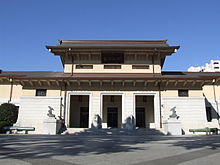Yasukuni shrine
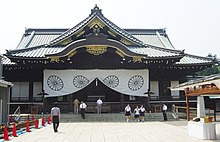
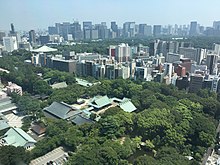
The Yasukuni Shrine ( jap. 靖國神社 , shinjitai : 靖国神社 , Yasukuni Jinja , "Shrine of the peaceful country") is a Shinto shrine in the district of Chiyoda , Tokyo in Japan . This commemorates the fallen members of the military who died on the side of the imperial armies during and since the Meiji Restoration of 1868 , as well as the fallen of all nations, including those who were opponents of the war.
He belongs to the Chokusaisha , which is why special emissaries of the Tennō are sent there twice a year for the two most important festivals.
Regardless of the historical and political significance of the park at the Yasukuni Shrine also one of the most popular places for hanami -Frühlingsfest, and especially for the Yozakura mentioned evening Hanamis. The several dozen cherry trees are illuminated from below in the evening, which makes the blossoms appear almost like white clouds in the black night sky. Many Japanese combine a visit to hanami at Yasukuni with a walk to the nearby moat of the Imperial Palace . The moat is also surrounded by numerous cherry trees, which are also illuminated.
history
The Yasukuni Shrine was founded in 1869 under the name Tōkyō Shōkonsha (Tokyo shrine for calling up the spirits of the dead, shōkonsha were commonly called shrines for the worship of war dead) in the district of Chiyoda (immediately north of the Imperial Palace ) of the new capital Tokyo, where it still stands today . In the Shrine of all war dead as if kami and "heroic souls" ( 英霊 , eirei ) are thought to be on the imperial side in the restoration (such as the -Wirren Boshin War ) had fought. This was later extended to include the dead from other conflicts, such as the Japanese punitive expedition to Taiwan (May – December 1874). In 1879 the Tennō designated him a Bekkaku kanpeisha (imperial shrine of the special class) and gave him the name Yasukuni , based on the text passage waga motte kuni o yasunzuru nari (Japanese for Chinese 吾 以 靖 國 也 ) from the Chinese historical work Zuozhuan with the meaning " I did it to pacify the country ”.
At the same time - unusual for the shrine system at the time - it was placed directly under joint administration by the Ministry of the Interior , the Army and the Navy . From the Russo-Japanese War in 1904, in the event of a declaration of war, this was ritually read out to the dead at the Yasukuni Shrine. Likewise, the peace treaty was ritually presented to the spirits in an official state ceremony. The shrine served as the backdrop for mass military events, such as the victorious invasion after the war against Russia or the Army Day on April 30, introduced in 1907 . In 1934 General Araki Sadao reintroduced the traditional Japanese swords for officers, which were banned in the course of the Meiji Restoration in 1879. For this purpose he had a sword smithy set up at the Yasukuni shrine at the expense of the army, which produced around 8,000 swords by the end of the war in 1945
Because of the post-war constitution decreed separation of state and religion in the context of the abolition of State Shinto had the shrine are either secularized or dismissed from government responsibility. He opted for the latter and today has status as an independent religious body ( 独立 宗教 法人 , dokuritsu shūkyō hōjin ). The anecdote often repeated in popular literature, including on the shrine's website until 2010, that the Jesuit Bruno Bitter saved the shrine from demolition after the war through his intercession with General MacArthur has now been refuted. The demand, repeatedly made by conservative circles, to make the Yasukuni shrine a national memorial site has so far been opposed by the Japanese constitution. Nevertheless, it is visited by around six million Japanese every year, mainly by bereaved families, the influential veterans' associations, but also by nationalist associations .
On November 23, 2015, an explosive device exploded in the public toilet area inside the shrine, injuring no one. A South Korean was arrested in connection with the crime.
Shrunk kami
There are no dead buried in the shrine itself. In Shintō, cemeteries are generally considered to be unclean and therefore to be avoided. The Mitama - Matsuri on July 13th in her honor is of particular importance, when 5,000 lanterns are lit and religious dances are performed. Another festival is the Shūki-kōrei-sai from October 18-21 to comfort the souls of the fallen.
Those who fell for the emperor are thought of as kami in the honden (main hall) of the Yasukuni shrine. These are listed by name in a soul register that provides the following numbers:
| Fighting | year | caged kami |
|---|---|---|
| Boshin War / Restoration Confusion | 1868-1869 | 7,751 |
| Japanese punitive expedition to Taiwan | 1874 | 1,130 |
| Satsuma rebellion | 1877 | 6,971 |
| First Sino-Japanese War | 1894-1895 | 13,619 |
| Boxer Rebellion | 1901 | 1,256 |
| Russo-Japanese War | 1904-1905 | 88,429 |
| World War I and Siberian Intervention | 1914-1922 | 4,850 |
| Jinan incident | 1928 | 185 |
| Occupation of Manchuria | 1931 | 17.176 |
| Second Sino-Japanese War | 1937-1945 | 191,250 |
| Second World War | 1941-1945 | 2,133,915 |
| Total: | 2,466,532 |
Those who fell in opposition to the emperor or who died in the war in general, regardless of their nationality, are again collectively thought of as kami in Chinreisha .
terrain
The main entrance to the area in front of the shrine is marked by the steel first torii ( 第一 鳥 居 , dai-ichi torii ), also called large torii ( 大鳥 居 , ōtorii ). Damaged over time by the weather, the original torii from 1943 had to be removed. The current one was built in 1974 and, at 25 m, is the highest in Japan.
This is followed by the Irei no Izumi ( 慰 霊 の 泉 ) - the "fountain to calm the souls" - and a bronze statue of Ōmura Masujirō ( 大村 益 次郎 銅像 , Ōmura Masujirō dōzō ), who is regarded as the founder of the modern Imperial Japanese Army and is very much himself for the Yasukuni Shrine. At the time of its construction in 1893, it was Japan's first western-style statue. To the left of the statue is the Ishi Torii ( 石 鳥 居 , German "stone torii") built in 1932 .
This is followed by the 2nd torii ( 第二 鳥 居 , dai-ni torii ). This was built in 1887 and is the largest bronze torii in Japan.
To the left of this is the Ōtemizusha ( 大 手 水 舎 ), a roofed fountain in which you ritually clean yourself by washing your hands and mouth before entering the actual shrine area. The building was donated to the shrine in 1940 by Japanese people living in the USA and, due to the use of granite, weighs 18 tons.
The main area of the shrine is entered through the Shimmon ( 神 門 , Eng . "Kami Gate"). This was completed in 1934 and is made of cypress wood, the two doors of which are decorated with two 1.5 m in diameter chrysanthemum coats of arms. In 1994 restoration work was carried out on the gate. Continuing straight ahead is the Chūmon Torii ( 中 門 „d, Eng." Middle Gate Torii ") as the 3rd Torii of the shrine. This was rebuilt in 2006 with cypress wood from Saitama .
Through this one reaches the Haiden ( 拝 殿 ) - the "prayer hall" - in which the shrine visitors show their respect and donate money. The Haiden was built in 1901 and the roof was renovated in 1989. The main building of the entire shrine complex is the Honden ( 本 殿 , Eng. "Main hall") behind it , in which the venerated kami are entrenched. The building was erected in 1872. The renovation began in 1986 and was completed in 1989. Behind the Honden is the Reijibo Hōanden ( 霊 璽 簿 奉安 殿 ) in which there are registers with the names of all those who are venerated in the shrine. The building was erected in 1972.
In front of the chūmon there is a path on the left that leads to the south gate ( 南門 , minami-mon ). In front of it a path leads along the Haiden and Honden , at the end of which the Motomiya ( 元 宮 ) and the Chinreisha ( 鎮 霊 社 , German: "Shrine for the pacification of souls") can be reached. The Motomiya was originally built in secret by loyalists to the emperor in Kyoto to worship the fallen during the early Meiji Restoration in the 1860s and was thus the spiritual forerunner of the Yasukuni shrine. In 1931 it was finally moved to Tokyo on the grounds of the Yasukuni Shrine and was given its current name Motomiya - " Shrine of Origin". The Chinreisha was built in 1965. In it there are two za ( 座 , "(Kami-) seats"): one for those Japanese who fought against the imperial troops in the Boshin war or the restoration confusion and the other for the fallen of all other nations, also including the war opponents . The shrine is relatively unknown due to its hidden location and has not been accessible to the general public since 1975. However, offerings are made to those encamped in it twice a day.
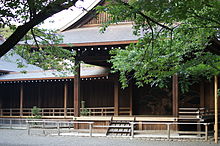
To the left of the Shimmon are the Saikan ( 斎 館 ) for the ritual cleansing of the priests and the shrine office ( 社 務 所 , shamusho ). Directly to the right of the Shimmon is a pigeon shed for white pigeons ( 白 鳩 鳩 舎 , shirohato kyūsha ), which houses the shrine's 300 white pigeons, and a no -theater stage ( 能 楽 堂 , nōgakudō ). The stage was built in Shiba Park in 1881 and moved to the shrine in 1903. The stage is also on the left at the beginning of a path leading from the north gate ( 北 門 , kita-mon ), while the Yūshūkan Museum ( 遊 就 館 ) is on the right .
Following the path further is the Sanshūden ( 参 集 殿 , German "assembly hall") built in 2004 on the left at the forecourt of the Haiden and then to the right of the Honden the Tōchakuden ( 到 着 殿 , German "reception hall"). There is a large square to the right of the path. On the way side there is a line of statues with 3 animal statues: the 1982 erected "Statue for the pacification of the souls of the horses fallen on the battlefield" ( 戦 歿 馬 慰 霊 像 , sembotsuma ireizō ), the 1982 erected "Tower of the pigeon souls " ( 鳩 魂 塔 , kyūkontō ) called Hato to Chikyūgi ( 鳩 と 地球 儀 , dt. "Dove and Globe") to the worship of the carrier pigeons used in the war and the March 1992 erected "statue to calm the souls of the army dogs" ( 軍犬 慰 霊 像 , gunken ireizō ) one German Shepherd Dog . On the opposite side of the square there is a "statue of the mothers" ( 母 の 像 , haha no zō ), erected in 1974 , showing a war widow with three children, a "statue of the brave Tokkō warriors [d. H. Kamikaze Pilots] ”( 特 攻 勇士 の 像 , tokkō yūshi no zō ) and a monument erected in 2005 in honor of Radhabinod Pal ( パ ー ル 博士 顕 彰 碑 , Pāru-hakase kenshōbi , dt.“ Dr. Pal memorial stone ”), the as an Indian representative at the Tokyo trials , pleaded for acquittal for all defendants, as he saw the trials as victorious justice.
Statue in honor of the kamikaze pilots
The Yasukuni Kaikō Bunko ( 靖 国 偕行 文庫 ) is the archive of the Yasukuni shrine. It opened on October 7, 1999 and contains 100,000 volumes of material on the deaths of those worshiped in the shrine. The archive is open to the general public.
At the Shōkon Saitei ( 招魂 斎 庭 ), a place for invoking the souls of the deceased past at the end of the path, is the Shinchi Teien ( 神池 庭園 ) - the ornamental garden of the sacred pond - which was created in the early Meiji period and in 1999 was restored, and on this the three teahouses Senshintei ( 洗 心 亭 , dt. "Pavilion of the purified heart"), Seisentei ( 靖 泉 亭 , dt. "Pavilion of the peaceful source") and Kōuntei ( 行 雲亭 , dt. "Pavilion of the floating clouds ”). At the far right end of the shrine is a sumo ring ( 相撲 場 , sumo-ba ) with free entry. This was built in 1869 on the occasion of a sumo competition during the dedication festival of the Yasukuni shrine. Yokozuna competitions are held here every year for the spring tournament.
Yūshūkan Museum
The Yūshūkan Museum opened in 1882 and expanded in 2002. In this Japanese history is transfigured and an ideal of the samurai as a loyal servant is celebrated according to the philosophy of Bushidō , which has nothing to do with a neutral view of history. Thus, Oda Nobunaga portrayed as loyal to the emperor realm unifier - the latter can be credited to him, he was the former less. The Second World War is also transfigured in the spirit of the conservative revisionists: the Great East Asian War is not referred to as a war of aggression, but rather portrayed as a holy war aimed at liberating Asia from Western colonialism ( Greater East Asian Prosperity Sphere ). The Nanking massacre is also played down in the museum, which culminates in the phrase that “by taking the city, peace came back to Nanking”, a statement taken from a contemporary newspaper from December 1937. The suffering of the Japanese prisoners (especially in Russian camps) is portrayed, but not that of the Korean and Chinese.
Weapons are also on display in the museum. The collection ranges from old katana and armor to equipment and weapons from World War II, such as a fighter jet ( Mitsubishi A6M ), a manned glide bomb ( Yokosuka MXY-7 ) intended for kamikaze attacks , and artillery pieces.
In the museum, self-sacrifice for the emperor and fatherland is presented as a sacred sacrifice. The tenor of the museum, as of the entire shrine complex, is expressed on a bronze plaque unveiled on the occasion of the 40th anniversary of the attack on Pearl Harbor : “ Almost six thousand men died in suicide attacks, whose tragic heroism is unprecedented and the hearts of our enemies Fear froze. The entire nation has shed tears of gratitude for its unwavering loyalty and self-sacrifice. "
For visitors who do not speak Japanese, the museum also offers explanatory texts in English. These explanations do not gloss over the content in any way, but are sometimes even more provocative than the Japanese original texts.
Political importance
Political Debate in Japan
Japanese from right-wing circles point out that this is not a war memorial in the sense of nationalist propaganda , as critics claim, but a shrine in which the angry souls of the deceased are to be appeased so that they do not cause unrest in the country. This opinion is also supported by international research on Japanese cultural history. Far right, on the other hand, point out that in the USA heroes' cemeteries for those who died in various wars and corresponding commemorative events are normal and that Japan also has a right to them. They are demanding that the shrine be taken over by the government as the official shrine office . Corresponding proposals failed several times in parliament in the 1970s.
Left-wing critics, on the other hand, are calling on Japan to turn away from all forms of militarism and to deal critically with its own history in view of the crimes committed by Japan in the Second World War. The fact that the officers sentenced to death in the war crimes trials in Tokyo and members of the notorious Unit 731 , which carried out experiments with biological weapons on prisoners of war and Chinese civilians during the war in Manchuria, are particularly sharply criticized .

The international criticism, especially from North and South Korea as well as from the Republic and the People's Republic of China , is directed primarily at the official visits of high-ranking Japanese politicians. Visits on August 15, the day of the surrender, are particularly criticized, as this is seen as a clear glossing over of the war. The first prime minister to make an official visit on August 15 was Nakasone Yasuhiro in the 1980s. Almost all of the prime ministers had previously visited the shrine, but had declared their visits unofficial or scheduled the visit for a date other than August 15. The first visit by a prime minister on August 15 was that of Prime Minister Miki Takeo in 1975.
In Japan, attempts are being made to defuse the situation by making a subtle distinction between private visits (the fathers of some high-ranking politicians are venerated in the shrine as fallen war) and visits in an official capacity. The external impact remains the same, however, and so there are repeated demonstrations in both China and South Korea, and diplomatic relations are also strained. Former Prime Minister Koizumi Junichirō ( LDP ) has visited the shrine every year since taking office in 2000 through 2006. From 2000 to 2005 he always visited the shrine on different dates, but never on August 15. In 2004 he had left an entry in the guest book as " Prime Minister Koizumi Junichiro ", which was also heavily criticized within Japan because the constitution provides for the separation of state and religion. In 2005, he did not enter himself in the guest book and did not enter the interior of the shrine either to emphasize the private nature of the visit. Nevertheless, there were protests from Korea and China, which canceled a visit by the Japanese foreign minister (a number of other high-ranking LDP politicians also visited the shrine on August 15, 2005), but also renewed waves of criticism in Japan. So Koizumi decided to schedule his last visit as prime minister on August 15th. "If I am always criticized, no matter when and how I visit the shrine, then I can go on August 15th and it makes no sense to avoid visiting on that day," said the Prime Minister in a press conference after his Visit on August 15, 2006.
Public opinion in Japan about the visits is divided. A small majority of the Japanese mostly reject the visits in surveys, but around 60% of the LDP supporters are in favor.
For a long time it was a tradition that the Tennō visited the shrine during the annual festival from April 21st to 25th to worship the fallen. After the new high priest Nagayoshi Matsudaira had class A war criminals ( crimes against world peace ) added to the list of kami in 1978 , Tennō Hirohito ended his visits from a lack of understanding, as did his successor Akihito . As early as 1959, 1,068 "Class B and C" war criminals were included in the list of "kami".
These 14 war criminals of "Class A" are Tōjō Hideki , Doihara Kenji , Hirota Kōki , Itagaki Seishirō , Kimura Heitarō , Matsui Iwane , Mutō Akira (each with death sentence), Hiranuma Kiichirō , Koiso Kuniaki , Shiratori Toshio , Umezu Yoshijirō Haft) (each life) , Tōgō Shigenori (20 years imprisonment), and Matsuoka Yōsuke and Nagano Osami , who died before the end of the trial.
In the shrine itself, in brochures and today on its website, the Tokyo trials, which were organized by the Allies in 1946 in a similar way to the Nuremberg trials , are referred to as show trials , the result of victorious justice. Japan confirmed the rulings of the Tokyo trials in the 1951 peace treaty of San Francisco , so the rulings are part of international treaties. Yet today even high-ranking politicians like Jun'ichirō Koizumi and his successor Shinzō Abe are questioning the legitimacy of the trials.
On the anniversary of the Japanese surrender in 2010, no minister visited the controversial Yasukuni Shrine in Tokyo for the first time. On December 26, 2013, Shinzō Abe, a Japanese prime minister, visited the shrine for the first time in seven years, including the Chinreisha, which sparked protests in China and South Korea.
Protests of the former colonies
There were protests from the North and especially from the South Korean side, as not only the voluntary, but also the numerically larger group of forcibly recruited Korean people are venerated in the shrine and their names are not deleted from the lists despite the protests of relatives.
(Forced) recruits from Taiwan, also a former Japanese colony (1895-1945), are venerated in the shrine. In Taiwan, however, there is less rebellion, because on the one hand the verdict on the period of Japanese colonial rule was milder and on the other hand they do not want to snub Japan for political reasons. Protests are particularly loud among the indigenous people of Taiwan. For example, the Taiwanese parliamentarian and former actress Gaojin Sumei traveled to Japan in June 2005. She traveled to Tokyo with a delegation of indigenous people who represented nine tribes and wanted to ask for the relatives to be relocated in the shrine and to demonstrate peacefully at Yasukuni Shrine against the atrocities of the Japanese against the Taiwanese indigenous people . However, the group was denied entry to the shrine.
Cultural references
Music with the Yasukuni shrine as a motif
- Yasukuni no (Yasukuni) from 1937
- The song says:
- Yasukuni no miya ni mitama wa shizumaru mo (Your noble spirit rests in the Yasukuni shrine, my son.)
- Oriori kaere haha no yumeji ni (Return to your mother every now and then, at least in dreams.)
- In this tanka a mother mourns the loss of her son who died in the Pacific War . The professional soldier Ōe Hifumi wrote the minimalist text as an eulogy for a young comrade who died in August 1937. The poem became known throughout Japan in 1937 through the 39-second song Yasukuni no , the manner of which is attributed to the composer Kiyoshi Nobutoki (信 時 潔). The song quickly developed into a common requiem and was included in the radio series Kokumin Kayō ("National Songs ") of the Japanese broadcasting company NHK . In addition to the many radio broadcasts, the live radio reports of the worship rituals at Yasukuni Shrine also made the song better known. After Japan's defeat in the war in 1945 , it disappeared like other “national songs” from the collective memory of the Japanese nation. The song regained importance in 1984 - amid the controversy over the repeated visits of Prime Minister Nakasone Yasuhiro to the Yasukuni Shrine - when its text was presented as a cultural artifact symbolizing the problem surrounding the Yasukuni Shrine, according to the publication Yasukuni Jinja (1984 ) by the historian Ōe Shinobu, a son of Ōe Hifumi.
- 同期 の 桜 , Dōki no sakura (cherry blossoms of the same class) from 1938
- The song says:
-
貴 様 と俺 と は同期 の桜 , kisama to ore to wa dōki no sakura (you and I are two cherry blossoms) -
離 れ離 れ に散 ろ う と も , hanarebanare ni chirō tomo (Even if our flowers fall apart) -
花 の都 の靖国神社 , hana no miyako no Yasukuni jinja (The capital of flowers is Yasukuni-jinja) -
春 の梢 に咲 い て会 お う , haru no kozue ni saite aō (We will meet again in the treetops in spring) - Dōki no sakura is a song dedicated to the "selfless sacrifice" of the kamikaze pilots, who compares it to cherry blossoms that would bloom in their most beautiful hour and then pass away shortly afterwards. The symbolic complex “to fall like cherry blossoms for the emperor / the country” had already begun to find expression in song lyrics of that time after the victories in the Sino -Japanese War at the end of the 19th century and in the Russo-Japanese War at the beginning of the 20th century when patriotic euphoria gripped many Japanese .
Banknotes with the Yasukuni shrine as a motif

- The 50-sen banknote of the Japanese Empire issued from 1942 onwards used the Yasukuni shrine as a motif.
Postage stamps with the Yasukuni Shrine as a motif
- Japanese 17 sen postage stamp (1943)
- Japanese 27 sen postage stamp (1945)
- Japanese 1 yen postage stamp (1946)
See also
literature
- Klaus Antoni : The heavenly ruler and his state. Essays on the position of the Tennô in modern Japan. Munich: iudicium, 1991.
- Isa Ducke and Sven Saaler (eds.): Japan and Korea at the beginning of the 21st century. Tasks and perspectives. Munich: Iudicium (= monographs from the German Institute for Japanese Studies, 36), 2003.
- Ernst Lokowandt: On the relationship between the state and Shintô in Japan today. Wiesbaden: Otto Harrassowitz (Studies in Oriental Religions 6), 1981
- Mark Mullins: How Yasukuni Shrine Survived the Occupation. Monumenta Nipponica , Vol 65, No 1 (2010), pp. 89-136, doi : 10.1353 / mni.0.0109
- Michael Pye: Religion and Conflict in Japan with Special Reference to Shinto and Yasukuni Shrine. in: Diogenes 50: 3 (2003), pp. 45-59.
- Tino Schölz: "Appease the fallen and praise their deeds". The cult of favor and the political constitution in Japan since the middle of the 19th century . Berlin, deGruyter Oldenbourg, 2016.
- Sven Saaler: Politics, Memory and Public Opinion . Munich, iudicium, 2005.
- Sven Saaler: A replacement for the Yasukuni shrine? The discussion about a new memorial for Japan's war victims. In: Nachrichten der Gesellschaft für Natur- und Volkerkunde Ostasiens (NOAG) 175/176 (2004), pp. 59–91. ( as PDF )
- John Breen: Yasukuni Shrine: Ritual and Memory . Japan Focus dated June 3, 2005
- John Nelson: Social Memory as Ritual Practice: Commemorating Spirits of the Military Dead at Yasukuni Shinto Shrine . Journal of Asian Studies 62, 2 (May 2003): 445-467.
Web links
- Yasukuni Shrine Official Website - Japanese and English
- Official website of the Japanese Ministry of Foreign Affairs on Prime Minister Koizumi's Yasukuni visits - English
- Mark Selden: Japan, the United States and Yasukuni Nationalism: War, Historical Memory and the Future of the Asia Pacific , in: Japan Focus ; Retrieved September 6, 2006 - English
- Takahashi Tetsuya: “ Yasukuni Shrine at the Heart of Japan's National Debate: History, Memory, Denial ”, in: Japan Focus ; Retrieved October 17, 2014 - English
- Japonologist Verena Blechinger-Talcott on the visit on August 15, 2006 , Deutsche Welle
Individual evidence
- ↑ Andrew J. Drea: Japan's Imperial Army. Lawrence, 2009, p. 50, pp. 122-123, p. 176
- ↑ Mullins (2010), pp. 90ff. ( Old Yasukuni website from April 5, 2008 ( Memento from April 5, 2008 in the Internet Archive ))
- ↑ Entry with GTD ID 201511230072 in the Global Terrorism Database of the University of Maryland, accessed April 30, 2018 .
- ↑ Explosion damages toilet at Japan's controversial shrine for war dead. In: Reuters. November 23, 2015, accessed November 25, 2018 .
- ↑ 靖國神社 概要 . Yasukuni Shrine, October 17, 2004, archived from the original on July 18, 2006 ; Retrieved October 14, 2012 (Japanese).
- ↑ 31. Statue of Omura Masujiro. Yasukuni Shrine, archived from the original on January 11, 2009 ; accessed on May 21, 2009 .
- ↑ 32. Daiichi Torii (First Shrine Gate or Great Gate). Yasukuni Shrine, archived from the original on January 11, 2009 ; accessed on May 21, 2009 .
- ↑ 39. Ishi Torii (Stone Shrine Gate). Yasukuni Shrine, archived from the original on January 11, 2009 ; accessed on May 21, 2009 .
- ↑ 11. Daini Torii (Second Shrine Gate). Yasukuni Shrine, archived from the original on January 11, 2009 ; accessed on May 21, 2009 .
- ↑ 9. Otemizusha (Main Purification Font). Yasukuni Shrine, archived from the original on January 11, 2009 ; accessed on May 21, 2009 .
- ↑ 10. Shinmon (Main Gate). Yasukuni Shrine, archived from the original on January 11, 2009 ; accessed on May 21, 2009 .
- ↑ 7. Chumon Torii (Third Shrine Gate). Archived from the original on January 11, 2009 ; accessed on May 21, 2009 .
- ↑ 3. Haiden (Main Hall). Yasukuni Shrine, archived from the original on December 11, 2008 ; accessed on May 21, 2009 .
- ↑ 1. Honden (Main Shrine). Archived from the original on January 11, 2009 ; accessed on May 21, 2009 .
- ↑ 2. Reijibo Hoanden (Repository for the Symbolic Registers of Divinities). Archived from the original on January 11, 2009 ; accessed on May 21, 2009 .
- ↑ 4. Motomiya (Original Shrine). Archived from the original on January 11, 2009 ; accessed on May 21, 2009 .
- ↑ John Breen: Yasukuni Shrine: Ritual and Memory. In: The Asia-Pacific Journal: Japan Focus. June 3, 2005, accessed July 18, 2013 .
- ↑ 30. Dove cote. Yasukuni Shrine, archived from the original on January 11, 2009 ; accessed on May 21, 2009 .
- ↑ 12. Nogakudo (Noh Theater). Yasukuni Shrine, archived from the original on January 11, 2009 ; accessed on May 21, 2009 .
- ↑ 13. Sanshuden (Assembly). Archived from the original on January 11, 2009 ; accessed on May 21, 2009 .
- ↑ 28. Statues honoring horses, carrier pigeons and dogs killed in war service. Archived from the original on January 11, 2009 ; accessed on May 21, 2009 .
- ↑ 23. Statue of War Widow with Children. Archived from the original on January 11, 2009 ; accessed on May 21, 2009 .
- ↑ 靖国神社 周 辺 . In: TOKYO 銅像 マ ッ プ . Retrieved May 21, 2009 (Japanese).
- ↑ 24. Monument of Dr. Pal. Retrieved May 21, 2009 .
- ↑ 21. Yasukuni Kaiko Bunko (Yasukini Archives). Archived from the original on January 11, 2009 ; accessed on May 21, 2009 .
- ↑ 15. Shinchi Teien (Sacred Pond Garden). Archived from the original on January 11, 2009 ; accessed on May 21, 2009 .
- ↑ 19. Sumo Ring. Archived from the original on January 11, 2009 ; accessed on May 21, 2009 .
- ↑ 25. Yushukan. Archived from the original on January 11, 2009 ; accessed on May 21, 2009 .
- ↑ 靖国神社 法案 Mullins, Mark; How Yasukuni Shrine Survived the Occupation; Monumenta Nipponica , Vol 65 (2010), p. 89
- ↑ Hirohito quit Yasukuni Shrine visits over concerns about war criminals. In: The New York Times. April 26, 2007, accessed September 23, 2015 .
- ↑ Japan's Prime Minister apologizes ( memento from August 19, 2010 in the Internet Archive ) sueddeutsche.de, August 16, 2010
- ↑ Declaration by Prime Minister Shinzo Abe - “Vows for Eternal Peace”. Ministry of Foreign Affairs of Japan, December 26, 2013, accessed October 18, 2014 .
- ↑ Japan's premier visits controversial war shrine, orf.at of December 26, 2013.
- ↑ Taiwan Natives' Yasukuni Protest Unfulfilled Due to Obstruction ( Memento from August 11, 2013 in the web archive archive.today )
- ↑ Akiko Takenaka: Yasukuni Shrine - History, Memory, and Japan's Unending Postwar . In: Studies of the Weatherhead East Asian Institute, Columbia University . University of Hawaii Press, 2015, ISBN 978-0-8248-4678-7 , pp. 1-278 .
- ↑ Bjorn Koolen: Yasukuni, The Soft Power of Clashing Identities . In: IAFOR Journal of Politics, Economics & Law . tape 3 , no. 1 , 2016, ISSN 2188-9562 , p. 35-48 , doi : 10.22492 / ijpel.3.1.04 .
- ↑ Emiko Ohnuki-Tierney: Kamikaze, Cherry Blossoms, and Nationalisms - The Militarization of Aesthetics in Japanese History . University of Chicago Press, 2002, ISBN 0-226-62068-9 , pp. 1-428 . Here p. 135.
Coordinates: 35 ° 41 ′ 39 " N , 139 ° 44 ′ 33.6" E





